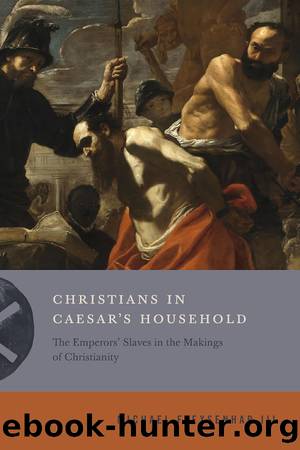Christians in Caesar's Household: The Emperors' Slaves in the Makings of Christianity by Michael Flexsenhar Iii

Author:Michael Flexsenhar, Iii [Michael Flexsenhar, Iii]
Language: eng
Format: epub
ISBN: 9780271082332
Google: ZRjbugEACAAJ
Publisher: PennStateUP
Published: 2019-09-15T20:39:54+00:00
Currents in Catacomb Study
It was once standard to view the miles of catacomb galleries beneath the streets of Rome as the exclusive burial ground for ancient Christians. This view, which predated but intensified in the ârediscoveryâ of the catacombs in the sixteenth century, continued during the nineteenth century with the veritable explosion of interest in the catacombs. The reasons for understanding Romeâs underground hollows as exclusively Christian sites are nearly as old and as complex as the catacombs themselves.6 But apart from an overt apologetic approach, textual sources such as the medieval Liber Pontificalis and especially a single sentence from Hippolytusâs Refutation of All Heresies were foundational to understanding the catacombs. According to the traditional interpretation of Hippolytusâs text, at the beginning of the third century Pope Zephyrinus put Callistus, the slave of a Christian from Caesarâs household, in charge of âthe cemeteryâ of the Christian community (Haer. 9.12). De Rossi, for his part, identified this cemetery as the Catacomb of Callixtus on the Via Appia, even though Callistus himself was evidently buried elsewhere (see appendix 2). De Rossiâs reading of the text from the Refutation of All Heresies then bolstered the view that Romeâs other catacombs were also collective and exclusive Christian burial spaces that the ecclesiastical authorities oversaw.7
Within this framework, the epigraphic, iconographic, and artistic material unearthed from the catacombs was presumed a priori to be Christian. Exceptions could be noted, though they were often purposefully ignored. The burden of proof was to show that an inscription was not a Christian one.8
A classic example of this is Orazio Marucchiâs analysis of an inscription that records an imperial freedman. The inscription was found âin the cemetery of Priscillaâ on the Via Salaria Nova in northern Rome. The marble, which was broken in three places, was a plaque (titulus) for a family tomb. The owner and dedicator was the imperial freedmanâthe name is lost to the lacunaâwho was also president of a tent-makers association (Aug(usti) lib(ertus) praepositus tabernaculo[rum---]).9 The plaque was found only a short distance from another inscription that enclosed a burial niche (loculus) and commemorated a wife named Bibia Corinthia. The cognomen Corinthia suggested to Marucchi that the wife was probably from Corinth originally. Marucchi could not âhelp but run with the thoughtâ that Aquila and Priscilla (or Prisca), the companions whom the apostle Paul met in Corinth, were also buried in the same cemetery. On De Rossiâs hypothesis, based on Romans 16:3â5, it was thought that the couple had returned to Rome, where they founded a house church on the Aventine Hill. The church was later known as La Chiesa di Santa Prisca, and was connected to the large cemetery on the Via Salaria named after Priscilla. The inscription for an imperial freedman in charge of tent-makers, combined with an inscription for a woman from Corinth, both of which were discovered in a cemetery that was ostensibly connected to Priscilla and Aquila, who like Paul were tent-makers, led Marucchi to exclaim: âWho would deny some probability that
Download
This site does not store any files on its server. We only index and link to content provided by other sites. Please contact the content providers to delete copyright contents if any and email us, we'll remove relevant links or contents immediately.
The Five People You Meet in Heaven by Mitch Albom(3456)
Real Sex by Lauren F. Winner(2949)
Name Book, The: Over 10,000 Names--Their Meanings, Origins, and Spiritual Significance by Astoria Dorothy(2925)
The Secret Power of Speaking God's Word by Joyce Meyer(2919)
The Holy Spirit by Billy Graham(2877)
0041152001443424520 .pdf by Unknown(2768)
ESV Study Bible by Crossway(2725)
How The Mind Works by Steven Pinker(2712)
Ancient Worlds by Michael Scott(2607)
The ESV Study Bible by Crossway Bibles(2494)
Churchill by Paul Johnson(2493)
The Meaning of the Library by unknow(2485)
The Gnostic Gospels by Pagels Elaine(2459)
MOSES THE EGYPTIAN by Jan Assmann(2360)
Jesus by Paul Johnson(2294)
City of Stairs by Robert Jackson Bennett(2293)
The Complete Dead Sea Scrolls in English (7th Edition) (Penguin Classics) by Geza Vermes(2222)
Ancient Near Eastern Thought and the Old Testament by John H. Walton(2183)
The Nativity by Geza Vermes(2165)
